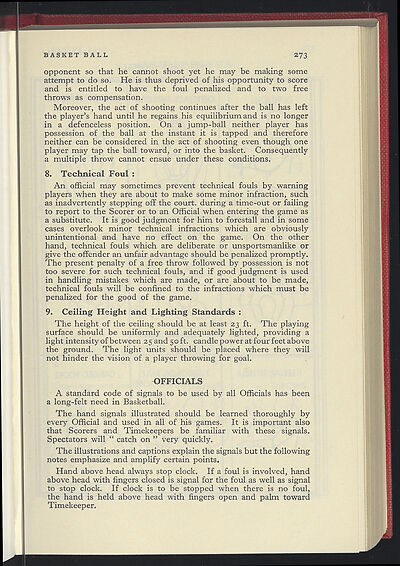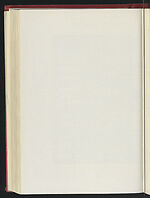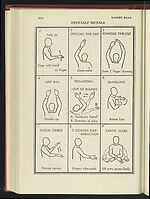1959-60
(335)
Download files
Complete book:
Individual page:
Thumbnail gallery: Grid view | List view

BASKET BALL
273
opponent so that he cannot shoot yet he may be making some
attempt to do so. He is thus deprived of his opportunity to score
and is entitled to have the foul penalized and to two free
throws as compensation.
Moreover, the act of shooting continues after the ball has left
the player's hand until he regains his equilibrium and is no longer
in a defenceless position. On a jump-ball neither player has
possession of the ball at the instant it is tapped and therefore
neither can be considered in the act of shooting even though one
player may tap the ball toward, or into the basket. Consequently
a multiple throw cannot ensue under these conditions.
8. Technical Foul :
An official may sometimes .prevent technical fouls by warning
players when they are about to make some minor infraction, such
as inadvertently stepping off the court. during a time-out or failing
to report to the Scorer or to an Official when entering the game as
a substitute. It is good judgment for him to forestall and in some
cases overlook minor technical infractions which are obviously
unintentional and have no effect on the game. On the other
hand, technical fouls which are deliberate or unsportsmanlike or
give the offender an unfair advantage should be penalized promptly.
The present penalty of a free throw followed by possession is not
too severe for such technical fouls, and if good judgment is used
in handling mistakes which are made, or are about to be made,
technical fouls will be confined to the infractions which must be
penalized for the good of the game.
9. Ceiling Height and
Lighting Standards
The height of the ceiling should be at least 23 ft. The playing
surface should be uniformly and adequately lighted, providing
a
light intensity of between 25 and
50
ft. candle power at four feet above
the ground. The light units should be placed where they will
not hinder the vision of a player throwing for goal.
-OFFICIALS
A standard code of signals to be used by all Officials has been
a long-felt need in Basketball.
The hand signals illustrated should be learned thoroughly by
every Official and used in all of his games. It is important also
that Scorers and Timekeepers be familiar with these signals.
Spectators will " catch on " very quickly.
The illustrations and captions explain the signals but the following
notes emphasize and amplify certain points.
Hand above head always stop clock. If a foul is involved, hand
above head with fingers closed is signal for the foul as well as signal
to stop clock. If clock is to be stopped when there is no foul,
the hand is held above head with fingers open and palm toward
Timekeeper.
273
opponent so that he cannot shoot yet he may be making some
attempt to do so. He is thus deprived of his opportunity to score
and is entitled to have the foul penalized and to two free
throws as compensation.
Moreover, the act of shooting continues after the ball has left
the player's hand until he regains his equilibrium and is no longer
in a defenceless position. On a jump-ball neither player has
possession of the ball at the instant it is tapped and therefore
neither can be considered in the act of shooting even though one
player may tap the ball toward, or into the basket. Consequently
a multiple throw cannot ensue under these conditions.
8. Technical Foul :
An official may sometimes .prevent technical fouls by warning
players when they are about to make some minor infraction, such
as inadvertently stepping off the court. during a time-out or failing
to report to the Scorer or to an Official when entering the game as
a substitute. It is good judgment for him to forestall and in some
cases overlook minor technical infractions which are obviously
unintentional and have no effect on the game. On the other
hand, technical fouls which are deliberate or unsportsmanlike or
give the offender an unfair advantage should be penalized promptly.
The present penalty of a free throw followed by possession is not
too severe for such technical fouls, and if good judgment is used
in handling mistakes which are made, or are about to be made,
technical fouls will be confined to the infractions which must be
penalized for the good of the game.
9. Ceiling Height and
Lighting Standards
The height of the ceiling should be at least 23 ft. The playing
surface should be uniformly and adequately lighted, providing
a
light intensity of between 25 and
50
ft. candle power at four feet above
the ground. The light units should be placed where they will
not hinder the vision of a player throwing for goal.
-OFFICIALS
A standard code of signals to be used by all Officials has been
a long-felt need in Basketball.
The hand signals illustrated should be learned thoroughly by
every Official and used in all of his games. It is important also
that Scorers and Timekeepers be familiar with these signals.
Spectators will " catch on " very quickly.
The illustrations and captions explain the signals but the following
notes emphasize and amplify certain points.
Hand above head always stop clock. If a foul is involved, hand
above head with fingers closed is signal for the foul as well as signal
to stop clock. If clock is to be stopped when there is no foul,
the hand is held above head with fingers open and palm toward
Timekeeper.
Set display mode to:
![]() Universal Viewer |
Universal Viewer | ![]() Mirador |
Large image | Transcription
Mirador |
Large image | Transcription
| Games and sports in the army > 1959-60 > (335) |
|---|
| Permanent URL | https://digital.nls.uk/248867393 |
|---|
| Description | 'Games and Sports in the Army' was an annual publication produced by the British War Office between the 1930s and 1960s. This included the Second World War. It outlines the rules and regulations for games and sports played by members of the armed forces. It features names and photographs of team members, and examples of contemporary advertising. |
|---|---|
| Shelfmark | GWB.52 |

